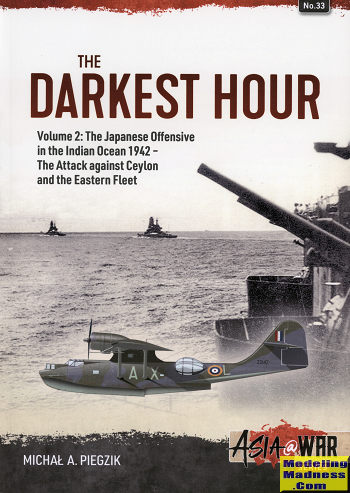 After
their success at Pearl Harbor along with their advances in southeast Asia, the
Japanese navy ventured farther west into the Indian Ocean and the Bay of Bengal.
The plan was to not only defeat the British Navy's Eastern Fleet in those areas,
but to sink as many merchant vessels as possible to prevent the rapid
reinforcement of troops in eastern India. This would allow the Japanese to more
quickly advance in Burma and Malaya, eventually cutting off the Chinese from
land reinforcement from the south.
After
their success at Pearl Harbor along with their advances in southeast Asia, the
Japanese navy ventured farther west into the Indian Ocean and the Bay of Bengal.
The plan was to not only defeat the British Navy's Eastern Fleet in those areas,
but to sink as many merchant vessels as possible to prevent the rapid
reinforcement of troops in eastern India. This would allow the Japanese to more
quickly advance in Burma and Malaya, eventually cutting off the Chinese from
land reinforcement from the south.
Using many of the same ships that participated in the
Pearl Harbor attack, the Japanese headed for the island of Ceylon, the home of
the greatest concentration of British forces. The plan was to destroy British
bases on the western side of the island. This would not only eliminate British
air power, but also make those bases unusable for the British fleet in the
Indian Ocean.
The first to be targeted was Colombo. The Japanese
approach was largely undiscovered, though the Japanese did discover two British
heavy cruisers and fairly easily dispatched both of them with carrier air power.
The force then launched several attacks on Colombo, which were fairly successful
in dealing a blow to both air and naval facilities as well as shooting down a
fair number of British aircraft. The next was Tricomalee a bit further up the
coast. They barely missed the British ships which had only recently left that
port. These ships left for further west and the British navy was absent from
this are until near the end of the war.
Meanwhile another smaller force entered the Bay of
Bengal and proceeded to harry shipping that was plying the eastern coast of
India. Again, they were fairly successful with the majority of shipping sunk in
this area being the result of gunfire from Japanese cruisers and destroyers. The
end result of these forays was a loss of Allied shipping plus several British
and Australian warships sent to the bottom. In return, Japanese losses were
minimal, being mostly the loss of some attacking aircraft. The Japanese then
left in order to have ships available for the Coral Sea and Midway battles.
Losses there and in Guadalcanal meant that the Indian Ocean was never revisited
save for Japanese submarines.
Japan's Indian Ocean foray is superbly covered in this
new book from Helion. The initial planning and then the execution of operation
is covered in considerable detail. What I liked is that the author provides
sufficient maps and charts in the proper place in the book so that we can follow
both the Japanese and British movements. This is something in which many other
books are lacking and these maps only increase the understanding of the
situation as it unfolds. As usual in this series, there are great period phots
as well as the usual full color profiles in the center section of the book. If
you want to know about this particular side story in the Pacific War, this is
the book you want.
January 2023
Copyright ModelingMadness.com. All rights reserved. No
reproduction without express permission.
Review book courtesy of
Casemate Publishers, where you can order your copy
at this
link.
If you would like your product reviewed fairly and quickly, please
contact the editor or see other details in the
Note to
Contributors.
 After
their success at Pearl Harbor along with their advances in southeast Asia, the
Japanese navy ventured farther west into the Indian Ocean and the Bay of Bengal.
The plan was to not only defeat the British Navy's Eastern Fleet in those areas,
but to sink as many merchant vessels as possible to prevent the rapid
reinforcement of troops in eastern India. This would allow the Japanese to more
quickly advance in Burma and Malaya, eventually cutting off the Chinese from
land reinforcement from the south.
After
their success at Pearl Harbor along with their advances in southeast Asia, the
Japanese navy ventured farther west into the Indian Ocean and the Bay of Bengal.
The plan was to not only defeat the British Navy's Eastern Fleet in those areas,
but to sink as many merchant vessels as possible to prevent the rapid
reinforcement of troops in eastern India. This would allow the Japanese to more
quickly advance in Burma and Malaya, eventually cutting off the Chinese from
land reinforcement from the south.